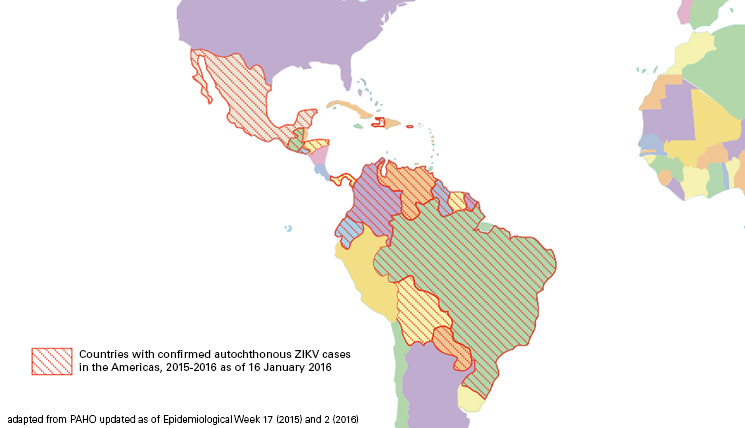In May 2015, the first case of Zika virus (ZIKV) infection was reported in Brazil. To date, the infectious disease has been primarily present in Asia and Africa, but since the beginning of 2015 it has spread across the Americas. ZIKV is transmitted by the same mosquitoes (Aedes aegypti, Aedes albopictus) as the dengue and chikungunya viruses which are endemic in this region. It also causes similar medical conditions: fever, rash, joint pain. However, the symptoms are usually milder and often, the infection proceeds unnoticed. This is one reason why the virus was not considered as a serious threat so far.
Over the last few weeks, however, it has become increasingly suspected that the acute wave of ZIKV infection in Brazil is linked to an alarming increase of microcephaly case numbers. Microcephaly describes a developmental aberration of the head, causing a comparatively small head circumference and often further disabilities of the newborn. The Brazilian Ministry of Health registered 1,248 cases in 2015 until November 28th which occured in 14 states that are also affected by ZIKV. For comparison: between 2010 and 2014 only 150 to 200 children suffered from microcephaly on average per year.
According to a report of the Ministry of Health from November 17th, genetic material was detected in the amniotic fluid of two pregnant women with indications for fetal microcephaly. The women themselves showed symptoms compatible with ZIKV infection. Only two weeks later, it was confirmed that a national reference laboratory (Evandro Chagas Institute) found ZIKV-RNA in blood and tissue samples of a newborn with microcephaly and additional congenital anomalies. The child died shortly after birth.
A primary suspicious fact on neurological consequences from ZIKV infections came up during a severe ZIKV disease outbreak in French Polynesia between 2013 and 2014. Several persons presented with inflammation of nerves, diagnosed as Guillain-Barré syndrome following a previous illness with a clinical picture compatible with ZIKV infection. The inflammation within the nervous system may cause dysesthesia and paralysis, often within the legs. Investigations are proceeding to explore a potential link between the infectious disease and the neurological manifestations.
In two comprehensive bulletins from November and December the „European Center for Disease Prevention and Control“ (ECDC) reasons that only “ecological evidences” exist for an association between microcephaly and ZIKV infections. The current data would not allow exclusion nor definite confirmation of a causal linkage until the ongoing investigations were completed.
But already the existing indications that ZIKV may be the reason for the growing number of congenital anomalies and cases of Guillain-Barré syndrome seem to be a wake-up call: WHO/PAHO “calls upon Member States to remain alert to the occurrence of similar events in their territories and to notify its occurrence (…)” (Epidemiological Alert, 17 November). Furthermore the capacity to detect and confirm ZIKV cases shall be established, healthcare facilities should be prepared for the possible increase in demand and the efforts to reduce the presence of mosquito vectors need to be continued (Epidemiological Alert, 1 December). The Brazilian Ministry of Health issues specific recommendations for pregnant women regarding increased protection against mosquito bites.
